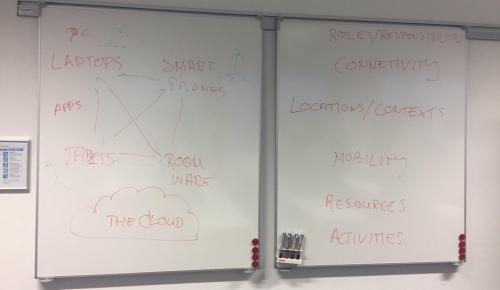On mobile learning in (Swiss) higher education
During the eduhub days in Luzern I had a workshop to introduce the eduhub SIG Mobile Learning with the great help of Marion. Of course, I gave a little outlook on our past activities, but I found that the workshop participants should better relate themselves to the activities of the special interest group and find out how they might contribute to the work of the SIG. Therefore, I asked the three main questions that drive our little sub-community and let the participants come up with their own ideas and responses. The discussions during the workshop were very fruitful and shed a light at the current state and challenges of mobile learning in Swiss higher education.
The three questions driving the SIG Mobile Learning are:
- Where do we stand with respect to mobile learning?
- Where do we want or need to be or what objectives we want to achieve in the realm of mobile learning but cannot achieve within our current institutional ecosystem?
- What are the next steps we need to take in order to better integrate mobile learning in the teaching at our home universities?
During the six years of working in the SIG, the main activities were focused on sharing practices on using apps as well as creating and sharing resources that are accessible on a wider range of student devices. Of course, this includes the sharing of the apps we have built for the use in our institutions. This showed, not much to our surprise, that there exist common needs and that there is much work duplicated without making much progress. These insights have led to joint activities on the "resource-challenge" and the "identity-challenge" (or the roles and responsibilities in the photo) for mobile learning.
Before we could address these questions during the eduhub days workshop, a more fundamental question has been raised by the participants: What is this mobile learning anyways? I kicked off with Eliott Soloways definition that mobile learning implies to get into the learning mode easily and quickly, so working with laptops under a tree would not be mobile learning. Soloway called this type of learning a few years back "carry around learning". However, with the device ecosystem of today's students that includes smart phones, e-book readers, tablets, and convertibles makes distinguishing between mobile and carry around learning somewhat weak. So the discussion with the workshop participants lead to characteristics such as connectivity, accessible, tailored or specialized resources, locations and contexts, learning activities that address the mobility of learners and of course the changing roles and responsibilities for learning. These characteristics raised questions on connecting the tools in our students' pockets with their study activities.
Clickers, flash-cards, and e-books but what about the LMS?
The participants reported from the present practice in their institutions include clicker apps for classroom engagement. Many specialized third party apps seem to be an element of the educational practice, among which flash card solutions are among the favorites. One participant mentioned that its institution is currently working on a mobile companion to support their students learning and study organization. A particularly difficult challenge appears the use of text-based learning resources, which often require annotation, which seems to be particularly difficult on smartphones, but then there are e-books in the ebub format that make this task easier but require that existing resources need transformation and redesign to work across devices. A critical remark was that the data from the learning management systems indicate that the use of mobiles to access these systems are constantly low despite their widespread availability. This could indicate that students don't really want to use their mobiles for learning. Another explanation could be that the institutional platforms are not really designed with mobility in mind but follow more a "mobile after" design principle as opposed to the famous "mobile first" approach. Another participant remarked that the low mobile use of the learning management systems could be due to limited suitable activities for supporting the mobility of students.
Moving educational technology systems away from the "mobile after" approach
By analysing at the landscape of the current mobile learning practice it shows that much teaching and learning happens in isolated tools and platforms that do or can not really follow the learners seamlessly across the device they have available in different learning environments. One solution for this could be that educators should rethink the institutional educational practice in order to free the students from narrow infrastructure requirements. Several remarks indicated that there is a big need for developing (educational) solutions in terms of good practices that can be used to bridge learning activities with the mobility of the learners in mind. The participants also mentioned that using mobiles to support the students' learning capabilities in terms of learning to learn would be of great benefit in and for their institutions. Finally, there is much unexplored potential for supporting portfolio work that learners can easily embed into their daily activities and practices.
Need for rethinking educational strategies for mobile learning
Among the various challenges identified by the participants, identifying activity islands and improving the ease of use of mobile tools within and across these islands was raised several times. Therefore, it is extremely important to develop a much better understanding about where students learn, how they use the various tools in their learning environments, and identify appropriate resources and activities that support students utilizing the devices within their range for their studies. For educators it is important to identify the learning scenarios and the special role and benefit of mobile devices for these scenarios. This task requires reflecting upon the students' learning needs and technology use in order to rethink our educational strategies and practice for expanding academic learning into the world of different forms of mobility.
